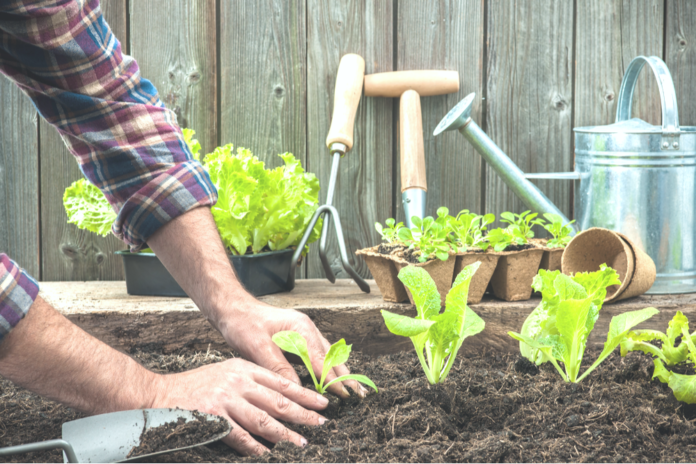Whether growing a personal, community, or indoor garden, the benefits of gardening flourish. Some of these benefits include lowering the risk for dementia and stress while being a fun way to get aerobic exercise.
Having a personal garden can also ensure healthy eating from home no matter how big or small the garden is. Get started on a personal garden project, either outside or inside with these helpful DIY project tips and ideas.
Best Plants for Home Gardening
There are many different plants that can fit into a DIY garden design. Answering the following questions will help one to decide what are the best plants based on what produce is desired, where the garden is, and what is best for the local area.
Decide What You Want Out of Your Garden
First thing is first: What do you want out of your garden? Do you want a vegetable garden? What about fresh herbs you can pick yourself? Do you want beautiful flowers?
Knowing what you want will help you focus on what plants are best for the garden. Keep the focus small to start for your garden, as you can add variety as your garden grows.
Indoor or Outdoor Garden?
Determining the best plants will depend on if the garden is indoor vs outdoor. Do you have space and the desire to plant outside? If so, the options are more open in terms of which plants can go grow and flourish. If options are indoors, there are still various options to pick from.
If indoor gardening is the option, check out which plants are considered the best indoor plants. If wanting some edible indoor plants, herbs and some pepper plants can also be grown indoors.
Know What Plants Grow Best in Your Area
Check if that plant will grow in your area. For example, tropical plants like avocados or oranges will not thrive outside in colder climates. Check a growing zone finder to match with desired fruits, vegetables, perennials, or annuals for compatibility.
It is also important to know when to plant according to where you live. Checking local growing guides can help determine when seeds should be planted.
Also reach out to local farmers, local plant stores and other gardeners in the community for best plants for your home garden and when to plant. They have great insight into tips for growing plants in the local region.
Setting Up a Garden Space
After determining which plants to grow, the next step is to set up a garden space. These simple step-by-step tips will help grow a garden from start to finish.
1. Pick the Garden Spot
Picking the right spot for an indoor or outdoor garden is an important key for success. Plants need the right amount of sunshine and the right type of soil.
The Old Farmer’s Almanac suggests planting a garden in a sunny location; vegetables need at least 6 hours of sunlight. If your garden area does not get that much sun, green leafy vegetables and other plants will tolerate more shade.
It is also important to pick a garden spot for an indoor garden. Determine where in the living area the plants will get the optimal amount of needed sunlight.
2. Get Simple Equipment Needed for Starting a Garden
No need for a lot of equipment for starting a garden; a few key pieces can make planting more efficient and productive. Dig or “till” the ground before planting as needed, which depends on the condition of the ground. This may require a simple shovel, tiller, or rototiller. Better Homes and Gardens suggests tilling helps cultivate the soil, but it is better to do too little rather than too much.
Another piece of equipment that can help is extra soil. Adding extra fertilized soil and/or compost before planting can help the garden be productive.
3. Give Plants Enough Space
Make sure when planting seeds or transplanting tiny plants they have enough space for each plant to grow. These tiny seeds/plants will hopefully grow into larger plants that will need more space. Overcrowded plants will not thrive as well as spaced-out plants. Instructions for spacing and depth of planting should be on seed packages or plant tags.
Remember to leave space in an outdoor garden for some sort of walkway for weeding and harvesting!
How to Plant In Pots or a Vertical Garden
Planting in pots or a vertical garden are great DIY garden ideas for small spaces. Growing plants up instead of out is possible, especially with the right equipment. Growing plants in pots, including hanging planters, cuts out the worry about tilling the ground for an outdoor garden.
Plant in Pots for Small Spaces
Indoor plants need to be planted in pots, but pots or container gardens are also ideal for small outside spaces like a porch, balcony, driveway, etc. If purchased a potted plant, consult the grower or employee for tips on growing. Keep in mind it is best to have a larger pot than you think you need compared to a smaller pot.
Things to consider for potting your own plants:
- Make sure there is enough room in the pot for the roots and soil needed as the plant grows.
- Choose a pot with drainage holes. Keep in mind if, for an indoor space, something under the pot to catch the extra water that drains out will be needed.
- Before filling a pot with soil, put it where you want it. This avoids having to move a heavy pot full of dirt.
- Special soil for pots might be needed. Good Housekeeping suggests for containers up to 1 gallon in size, use a houseplant soil mixture. For larger containers, use a relatively coarse soilless planting mixture to maintain the needed water and air balance.
Set Up for Vertical Garden
Vertical gardens can maximize a small space and add beauty to any indoor or outdoor area. Enjoy a vertical garden outside by setting up trellises in the garden for plants to grow up on.
Trellises can be also set up by a fence for a vertical garden, or prop up and secure a pallet along a fence. Fill the pallet with soil and plant in the openings. Plants that will grow up can include cucumbers, roses, morning glories, squash, and others.
Also, mount horizontal planters in rows onto a sturdy fence or wall for a vertical garden. This could work well for a flower or herb garden.
Overall, vertical raised garden beds or stackable, tiered vegetable or flower planters can be a low maintenance option if purchasing (or making) the stands.
Conclusion
Enjoy the benefits from gardening even without a green thumb or a large area for a garden. These simple tips can help get a garden started and guide decisions based on types of plant desired and where/how to plant them.
DIY garden ideas for either an indoor or outdoor space can include potting in plants or using vertical gardens. These two options can add creative ways to utilize space for more plants. Remember to also check with other local gardeners, farmers, and growers in your community!






